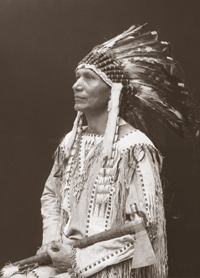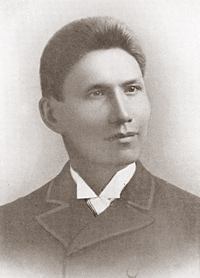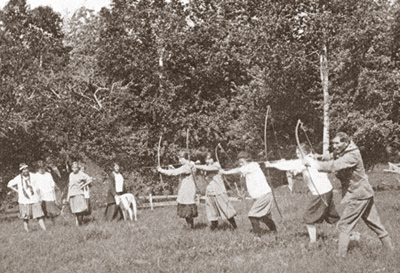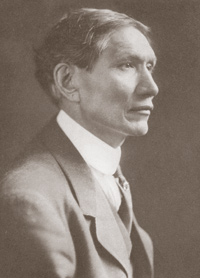 |
|
|
| OR |
|
|

|
|
|
|
|
|
|
|
|
|
Charles Eastman’s life and work
|
|
This site includes Charles Eastman’s biography, photos, online articles, slideshows, bibliography, and more.
|
|
|
|
|
|
|
Ohiyesa (Charles Alexander Eastman) was born in a buffalo hide tipi near Redwood Falls, Minn., in the winter of 1858. His father, “Many Lightnings” (Tawakanhdeota), was a full-blood Sioux. His mother was the granddaughter of the Sioux Chief “Cloud Man” and the daughter of Stands Sacred (Wakan inajin win) and a well-known army officer, Seth Eastman. His name at birth was “Hakadah,” the pitiful last, because he became the last of his three brothers and one sister when his mother died shortly after his birth. In his early youth he received the name Ohiyesa (The Winner).
The baby was initially raised in his homeland of Minnesota by his grandmother. At the age of four, the so-called “Sioux Uprising of 1862” occurred and he became separated from his father, elder brothers and only sister, whom the tribe thought had been killed by the whites. Hakadah fled into exile in Manitoba with the remaining members of his band of Santee Sioux. For the next eleven years he lived the original nomadic life of his people in the care of his uncle and his grandmother. His uncle was a prominent hunter and warrior and gave the youth, now named Ohiyesa, the complete training necessary to carry on the nomadic tribal heritage, including all of the secrets of virgin nature. Both his uncle and grandmother instilled in him the spiritual philosophy of the Indian. Ohiyesa always regarded this period of his life as his most important education.
At fifteen, Ohiyesa had just entered Indian manhood and was preparing to embark on his first war-path to avenge the reputed death of his father, when he was astonished by the reappearance of his father. The young man learned that this father had adopted the religion and customs of the hated race, and was come to take home his youngest son.
His father was part of a small group of progressive Indians who earned a living with a combination of farming and ranching on homesteads in Flandreau, Dakota Territory. After Ohiyesa’s first experience with a mission day school, he contemplated rebelling and leaving his new log home to return to the wild and his native ways. However after a long discussion with his father, he cut his long hair, began to wear white man’s clothing and applied himself to his new school life. He soon overcame his reluctance, although not his unhappiness with his new world, and two years later walked 150 miles to attend a better school at Santee, Nebraska. In this larger school he made rapid progress and upon the recommendation of his teacher, the renowned missionary educator, Dr. Alfred L. Riggs, Ohiyesa was accepted at to the preparatory department of Beloit College, Wisconsin. His father had adopted the English name of his wife’s father, Eastman, so the boy now named himself Charles Alexander Eastman.
Ohiyesa, now primarily known as Charles Eastman, spent two years at Beloit College before successively going to Knox College, Ill.; then Kimball Union Academy in New Hampshire, and finally to Dartmouth College. He graduated from Dartmouth in 1887, and then studied medicine at Boston University, where he graduated in 1890 as orator of his class. He spent a total of seventeen years in primary, preparatory, undergraduate college, and professional education, which is significantly less time than is required by a typical student.
During his studies in the East he made the acquaintance of many prominent people who would later help him further his career. With their help his first position was as Government Physician for the Sioux at the Pine Ridge reservation in South Dakota. He was at Pine Ridge before, during and after the “Ghost dance” rebellion of 1890-91, and he cared for the wounded Indians after the massacre at Wounded Knee. In 1891 he married a white woman who was also working at the Pine Ridge reservation, Miss Elaine Goodale of Berkshire County, Mass. Shortly after returning from his wedding in the East, the corrupt Indian agent forced Eastman to resign his job at the agency in retaliation for Eastman’s attempt to help the Sioux prove crimes against the agent and the agent’s white friends. In 1893 he, his wife and their new baby moved to St. Paul, Minnesota, where he started a medical practice. Shortly thereafter he accepted a position as field secretary for the International Committee of the YMCA, and for three years traveled extensively throughout the United States and Canada visiting many Indian tribes in an attempt to start new YMCA’s in those areas.
In 1897 Dr. Eastman went to Washington as the legal representative and lobbyist for the Sioux tribe. From 1899 to 1902 he again served as a Government physician to the Sioux at Crow Creek Agency, South Dakota. Starting in 1903, as an employee of the Indian Bureau, he spent over six years giving permanent English family names to the Sioux. In the process of creating both English names and family lineage records he met and interviewed almost every living member of the Sioux tribe.
His first book, Indian Boyhood, was published in 1902. It is the story of his own early life in the wilds of Canada, and it was an immediate public success generating public notoriety and a demand for more of his writings. He wrote a total of eleven books, including Red Hunters and the Animal People (1904), Old Indian Days (1906), Wigwam Evenings (1909), Smoky Day’s Wigwam Evenings: Indian Stories Retold (1910), The Soul of the Indian (1911), Indian Child Life (1913), Indian Scout Talks (1914), The Indian Today: The Past and Future of the First American (1915), From the Deep Woods to Civilization (1916) Indian Heroes and Great Chieftains (1918). All of his books were successful, some were used in school editions, and many were translated into French, German, Danish, and Czech languages. He also contributed numerous articles to magazines, reviews, and encyclopedias.
In 1910 Eastman began his long association with the Boy Scouts, helping Ernest Thompson Seton establish the organization based in large part on the prototype of the American Indian. It was also at about this time that he started to become in high demand as a lecturer and public speaker, traveling extensively in the US and abroad. Eastman was chosen to represent the American Indian at the Universal Races Congress in London in 1911. His public speaking continued for the remainder of his life.
Beginning in 1910 and for the rest of his life, Eastman also became involved with many progressive organizations attempting to improve the circumstances of the various Indian tribes. At one time he was president of the Society of American Indians, one prominent organization of that type.
From 1915 to 1920 the Eastman family created and operated a summer camp for girls, Oahe, at Granite Lake, New Hampshire, attempting to teach Indian life-ways to young girls.
He and his wife separated in August 1921. While the couple declined to comment on the reason for their separation, descendants later commented that they believed that the primary reason was the increasing dispute between the couple regarding the best future for the American Indian. Elaine Goodale Eastman stressed total assimilation of Native Americans into the dominant society and she apparently increasingly tried to dominate her husband’s views.[1] Eastman favored a type of cultural pluralism in which Indians would interact with the dominant society, utilizing only those positive aspects that would benefit them, but still retaining their Indian identity, including their traditional beliefs and customs; in effect living between two worlds. Eastman believed that the teachings and spirit of his adopted religion of Christianity and the traditional Indian spiritual beliefs were essentially the same and had their common origins in the same “Great Mystery;” a belief that was controversial to many Christians.
In 1928 Eastman purchased land on the north shore of Lake Huron, near Desbarats, Ontario, Canada. For the remainder of his life, when he was not traveling and lecturing, he lived there in his primitive cabin in communion with the virgin nature that he loved so dearly. In his last years he spent only the coldest winter months with his son in Detroit, where he died on January 8, 1939, at the age of eighty. For several years toward the end of his life he worked on a major study on the Sioux, but the project was never completed.
In his later adult life he was the foremost Indian spokesman of his day and his contribution to our understanding of the American Indian philosophy and religion are so significant that at the 1933 Chicago World’s Fair, Eastman was presented a special medal honoring the most distinguished achievements by an American Indian.
The above biography of Charles Eastman (Ohiyesa)was excerpted from the biographical notes at the end of The Essential Charles Eastman (Ohiyesa) (World Wisdom, 2007)
NOTES
[1] The interviews on which these conclusions are based are set forth in detail in the most authoritative biography on his life: Wilson, Raymond, Ohiyesa: Charles Eastman, Santee Sioux, University of Illinois Press, Urbana, 1983.
|
- Indian Boyhood: The True Story of a Sioux Upbringing, author, edited by Michael O. Fitzgerald and illustrated by Heidi M. Rasch
- Winner in the “Children’s Picture Book: Hardcover Non-Fiction” category of the 2016 USA “Best Book” Awards
- Silver Medal in the “Children’s Picture Books” category of the 2016 Midwest Book Awards
- Finalist in the 2016 Reading the West Awards (by MPIBA) for the “Children’s” category
- Living in Two Worlds: The American Indian Experience
- Winner in the “Multicultural Non-Fiction” category of The USA "Best Books 2011" Awards, sponsored by USA Book News
- Winner of the ForeWord Book of the Year Gold Medal in the “Social Science” category; finalist in the “History” category
- Winner of the Benjamin Franklin Gold Award for “Multicultural”
- 3 Gold Midwest Book Awards for: “Culture”, “Interior Layout”, and “Color Cover”
- 2 Silver Midwest Book Awards for: “History” and “Total Book Design”
- Finalist in two categories of The USA "Best Books 2011" Awards, sponsored by USA Book News:
– “Best Interior Design” (designers: Susana Marin and Michael Fitzgerald)
– “History: United States”
- The Essential Charles Eastman (Ohiyesa): Light on the Indian World
- Foreword Magazine Book of the Year Award Finalist for “Political Science”
|
 |
|
|
 |

This pdf file is an excerpt (pp. 6-17) of "Living in Two Worlds," a collection of writings by Charles Eastman (Ohiyesa), a Sioux Indian writer, doctor, and educator. These selections show both the beautiful illustrations found in the book, but also the style and character of the writing of Ohiyesa, a very important observer who was one of the few to fully experience and reflect in writing upon the "two worlds" of the traditional Indian way of life and the white man's way of life in the late nineteenth and early twentieth centuries.
| Living in Two Worlds (excerpt from pp. 6-17) | Living in Two Worlds | Eastman, Charles | | American Indian, Environment and Nature, Spiritual Life, Tradition |
|

|
|

| Selections from The Soul of the Indian | The Essential Charles Eastman (Ohiyesa): Light on the Indian World | Eastman, Charles | Fitzgerald, Michael | American Indian |
|

|
|
|
2 entries
(Displaying results 1 - 2)
|
View : |
|
Jump to: |
|
Page:
[1]
of 1 pages
|
|
 |
Loading... |
|
|
|
|
“In the process of bridging the gap between the traditional Indian world of his youth and the white world of his adult life, Ohiyesa (Charles Eastman) managed to preserve the teachings of his forefathers; lessons today's world needs and thirsts for. It is a small miracle that these important spiritual teachings have been preserved for us.
"In its efforts to include American Indians in the 'melting pot,' the United States Government nearly destroyed a way of life. Much of what we learn about American Indian spirituality today must be interpreted through the often imperfect efforts of non-Indians. Learning from Ohiyesa (Charles Eastman) is learning from the source.”
—James Trosper, Shoshone Medicine Man and Sun Dance Chief
“[Charles Eastman] did succeed in becoming an educated man, but what he came to realize is that if you lose your culture and traditions, you lose your identity not only as an Indian, but as a part of society. He learned that in the end it didn't matter how educated he was if he was not helping his people.”
—Adam Beach, native American actor, speaking in an interview with HBO about his role as Charles Eastman for the HBO Films production Bury My Heart at Wounded Knee
“Eastman was one of a very small number of Native Americans at the turn of the twentieth century to have authored book-length autobiographies in the modern Western tradition. As a founding member of the Society of American Indians (SAI), he belonged to the first official pan-Indian organization, served for a time as its president, and became a nationally recognized figure in support of Native causes. While he also worked for Anglo organizations such as the YMCA, the Boy Scouts of America, and the Carlisle School, his work always had strong Native American associations. Service of one kind or another was always central to his motivations.”
—Drew Lopenzina, Sam Houston State University, American Indian Quarterly
“Reflecting both his long-standing immersion in the bureaucracy of colonial domination and his desire to act as a cultural mediator between whites and Native Americans, Charles Eastman's Indian Boyhood is a complex and intriguing work. Like a number of his contemporaries (writers such as Sarah Winnemucca Hopkins, Zitkala-Ša, and Francis LaFlesche), Eastman set out to interpret Indian culture and identity for the benefit of his (hopefully sympathetic) white readership…At the same time, Eastman also frames his work as an autobiography, a sincere attempt to record, organize, and make sense of his own individual memories of the process of becoming "civilized." What is most interesting about Indian Boyhood is the complex way in which these personal and collective narratives intertwine.”
—David J. Carlson, California State University, San Bernardino, American Indian Quarterly
“After Wounded Knee, the ghost-dance movement quickly faded and the peyote movement swept through Indian country. Charles Eastman, on the other hand, left Pine Ridge in 1892 and went on to emerge as the most influential American Indian writer of his time.”
—Robert Allen Warrior, Oklahoma University, World Literature Today
“Ohiyesa, also known as Charles Alexander Eastman, was the first great American Indian author, publishing eleven books from 1902 until 1918. In his later adult life he was the foremost Indian spokesman of his day and his contribution to our understanding of the American Indian philosophy and religion are so significant that at the 1933 Chicago World’s Fair, Ohiyesa was presented a special medal honoring the most distinguished achievements by an American Indian.
"Eastman became the first and arguably the only American Indian to be raised until he was a young man in a completely traditional nomadic life, later receive both undergraduate and graduate college degrees and then continue to dedicate his life to the well being of his native peoples.”
—Michael Fitzgerald, author of Indian Spirit, Spirit of Indian Women, and The Essential Charles Eastman (Ohiyesa)
“The works of Ohiyesa are monumental treasures and must be appreciated for their singular nature. The chances of insight into the comprehensive Santee Sioux and plains Indian life is so slight. Given the crushing events of Ohiyesa’s time, the probability of finding another highly literate, fully knowledgeable member of Native society as well as American society like Ohiyesa, is miniscule.”
—Janine Pease, founder of the Little Big Horn College
“On that clear winter morning when in command of the search part that had reached the scene of the battle (at Wounded Knee), Dr. Charles Eastman became momentarily a man cast between two worlds. One was the world of the Grandfathers and his youth that had perished at Wounded Knee; and the other was the world of his white benefactors with its confusion of religions; its rigid interpretation of what was truly civilized; and its disinclination to tolerate any treat to progress.”
—Raymond Wilson, author of Ohiyesa: Charles Eastman, Santee Sioux
“Charles Alexander Eastman, the Sioux, Ohiyesa, is unique among Indian writers. No other writer moved so far culturally in a lifetime, from the tribal life of the Santee Sioux…to the white society of Dartmouth College and Boston University Medical School.... As a result, Eastman’s autobiographies, biographies and stories are told by him as he experienced and perceived them. His Indian contemporaries, on the other hand, have provided mainly "as told to" biographies, with all of the possible misunderstandings and misinterpretations which occur when there is a recorder or editor and often a translator as well.”
—Anne Lee Stensland, University of Minnesota, Duluth, American Indian Quarterly
 |
|
Indian Boyhood
———. New York: McClure, Philips & Co., 1902
———. Garden City, NY.: Doubleday, Page & Co., 1915
———. Boston: Little, Brown, & Co. [1924]
———. Greenwich, N.Y.: Fawcett Publications Ltd, 1970
———. New York: Dover Publications, 1971
———. Glorieta, N.M.: Rio Grande Press, [1976]
———. Lincoln: University of Nebraska Press, 1991
———. Alexandria, Va.: Time-Life Books, 1993
Red Hunters and the Animal People
———. New York and London: Harper & Brothers, 1904
———. New York: AMS Press, 1976
Old Indian Days
———. New York: The McClure Company, 1907
———. Boston: Little, Brown, & Co. [1924]
———. Lincoln: University of Nebraska Press, [1991]
Wigwam Evenings: Sioux Folk Tales (with Elaine Goodale Eastman)
———. Boston: Little, Brown, & Co. [1909]
———. Lincoln: University of Nebraska Press, [1990]
———. Mineola, N.Y.: Dover Publications, 2000
Smoky Day’s Wigwam Evenings; Indian stories Retold
———. Boston: Little, Brown, & Co, 1910
The Soul of the Indian: An Interpretation
———. Boston: Houghton Mifflin Co., 1911
———. New York: Johnson Reprint Corp., 1971
———. Lincoln: University of Nebraska Press, 1980
———. San Rafael, C.A.: New World Library, 1993
———. Mamaroneck, N.Y.: Aeon Pub. Co., 2000
———. New York: Dover Publications, 2003
Indian Child Life
———. Boston: Little, Brown, and Co., 1913
Indian Scout Talks: A Guide for Boy Scouts and Campfire Girls
———. Boston: Little, Brown, & Co., 1914
———. New York: Dover [1974]
The Indian Today: The Past and Future of the first American
———. Garden City, NY.: Doubleday, Page & Co., 1915
———. New York: AMS Press, 1975
From Deep Woods Into Civilization: Chapters in the Autobiography of an Indian
———. Boston: Little, Brown, & Co., 1916, 1920, 1925
———. Lincoln: University of Nebraska Press, 1977
———. Chicago: R. Donnelley & Sons Co., 2001
———. Mineola, N.Y.: Dover Publications, 2003
Indian Heroes and Great Chieftains
———. Boston: Little, Brown, & Co., 1918
———. Lincoln: University of Nebraska Press, [1991]
———. Mineola, N.Y.: Dover, 1997
 |
|
 |
 |
Photo of Charles Eastman (Ohiyesa) in traditional dress |
Photo of Charles Eastman (Ohiyesa) in 1890, when he received his medical degree at Boston University |
| |
 |
Photo of Charles Eastman (Ohiyesa) teaching archery at Camp Oahe. |
| |
 |
 |
Photo of Charles Eastman (Ohiyesa) and his daughter Dora in 1892 |
Photo of Charles Eastman (Ohiyesa) in 1916 |
|
|
•
The slideshow "Who was Charles Eastman?" is largely about Eastman's life. It adds a few details to the biography found above on this page, and includes a number of additional photographs.
Who was Charles Eastman (Ohiyesa)?
|
•
This slideshow is based on the award-winning book "Indian Spirit." Sayings of Indians from pre-reservation days are combined with photos to convey the "spirit" of their lifeways and perspective. A quote from Charles Eastman is included.
How can we understand Native American traditions?
|
|
|
|
|
|
|